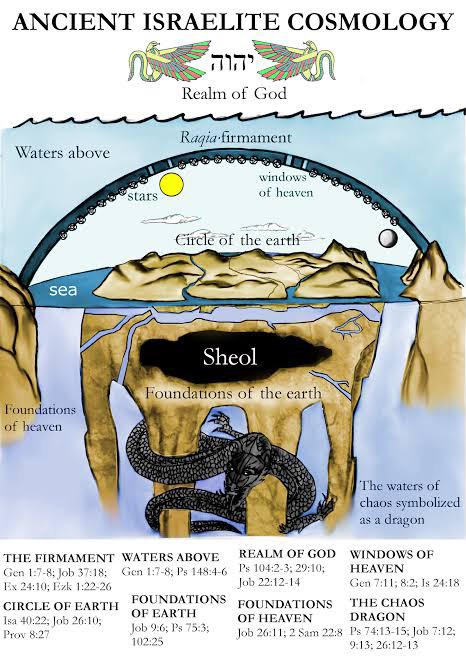Map of Locations in the Old Testament


David Chen
Data Visualization Specialist
David Chen is an expert in transforming complex geographic datasets into compelling visual narratives. He combines his background in computer science ...
Geographic Analysis
What This Map Shows
This map titled "The World According to the Old Testament" presents a geographical representation of locations mentioned in the Hebrew Bible. It highlights significant places such as Jerusalem, Egypt, Babylon, and the lands of the Patriarchs, allowing viewers to visualize the historical and cultural landscape of ancient narratives. By mapping these locations, we can better understand the geographical context of biblical events and their implications for the people of that time.
Deep Dive into Ancient Geographies
The Old Testament covers a vast array of geographical locations, each imbued with historical significance. The region often referred to as the Promised Land encompasses modern-day Israel and Palestine, an area steeped in ancient history and diverse cultures. This land is not just a backdrop for biblical stories; it is intricately tied to the identity of the Jewish people.
Interestingly, the geographical features of this region have played a crucial role in shaping the narratives within the Old Testament. For instance, the Jordan River serves as a natural boundary and a symbol of transition for the Israelites as they moved into Canaan. This river, approximately 251 kilometers long, is not only significant for its physical presence but also for its theological implications – representing both a literal and metaphorical passage into a new identity and covenant with God.
Moreover, the map illustrates places like Egypt, which held a dual significance in biblical stories. While it was a place of refuge for the Israelites during famine, it also became synonymous with oppression during their slavery. The story of Exodus, where Moses leads his people out of Egypt, is pivotal in Jewish history and identity.
The cities of Jerusalem and Bethlehem are also prominent on the map. Jerusalem, known as the City of David, is the spiritual center for Judaism. It is where key events occurred, such as the building of Solomon's Temple and the life of Jesus in the New Testament. Bethlehem, the birthplace of Jesus, connects the Old Testament to the New, showcasing the continuity of biblical narratives across time.
Interestingly, the cities of the ancient Near East, such as Babylon and Nineveh, also play crucial roles in the Old Testament. Babylon, often symbolizing exile and captivity, represents a significant period in Jewish history when many were carried off to serve in foreign lands. This exile profoundly affected Jewish identity and faith, leading to reflections on the importance of homeland and divine promise.
Regional Analysis
When analyzing the regions highlighted in the map, we see distinct variations in historical narratives and cultural significance. In the northern regions, such as the ancient kingdoms of Israel and Judah, the narratives often focus on kings, prophetic messages, and the struggles of maintaining faith amid political turmoil. In contrast, the southern areas, specifically around Jerusalem, are more centered on worship practices, temple worship, and the covenant relationship between God and His people.
Across the river valleys, such as those of the Euphrates and Tigris, we find the cradle of civilization. The interactions between the Israelites and surrounding nations are rich with cultural exchange, conflict, and theological dialogue. For example, the relationship between Israel and its neighbors, including the Philistines and Moabites, adds layers of complexity to the understanding of ancient geopolitics.
The map also sheds light on trade routes, such as the Via Maris, which facilitated commerce and cultural exchanges between Egypt, Canaan, and Mesopotamia. These routes were not merely physical paths but conduits of ideas, beliefs, and innovations that shaped the ancient world.
Significance and Impact
Understanding the geographical context of the Old Testament is crucial for interpreting its narratives. The locations on the map are not just historical sites; they represent the struggles, triumphs, and evolution of a people who have maintained their identity through millennia. The significance of these places continues to resonate today, influencing religious thought, cultural practices, and even political landscapes.
In contemporary discussions, the historical claims tied to these locations can sometimes be contentious. The ongoing Israeli-Palestinian conflict is deeply rooted in the historical narratives that this map illustrates. As such, the study of these ancient geographies is not merely an academic exercise but a vital endeavor for understanding current events and dialogues surrounding identity, belonging, and faith.
Looking ahead, as archaeological discoveries continue to emerge, our understanding of these ancient sites and their significance will evolve. Each excavation has the potential to reshape our perceptions and interpretations of the biblical narrative, reminding us that geography and history are inextricably linked, influencing not only past events but also the trajectories of future generations.
Visualization Details
- Published
- August 15, 2025
- Views
- 162
Comments
Loading comments...